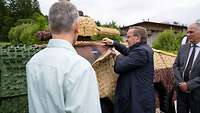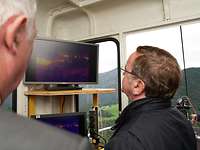Focus on Force Protection – Boris Pistorius Visits WTDWehrtechnische Dienststelle 52
News- Date:
- Place:
- Oberjettenberg
- Reading time:
- 3 MIN


On 3 August 2023, the Federal Minister of Defence, Boris Pistorius, visited the Bundeswehr Technical Centre for Protective and Special Technologies (“WTDWehrtechnische Dienststelle 52”) in Oberjettenberg, Upper Bavaria.
The agency makes important contributions to the testing of ever-improving protective technologies for the servicemen and women on operations. On site, the Minister was given an impressive demonstration of what is possible today.
Testing with a View
For its research and testing mission, WTDWehrtechnische Dienststelle 52 boasts an exceptional setting in alpine surroundings. Here, altitude can easily be taken into account as the “third dimension”.
The agency relies on Germany’s only state-owned aerial cableway, which is specially equipped: a measuring pod, i.e. a cable car fitted with a special laboratory camera and other measuring equipment, is available for testing purposes.
Camouflage – New Technologies to Close the Capability Gap
One of the core tasks of WTDWehrtechnische Dienststelle 52 is the indirect protection of servicemen and women through camouflage and concealment. Traditionally, camouflage has largely relied on purely optical deception. With the stationary multispectral camouflage net (“SMT”) and the mobile multispectral camouflage system (“MMTMultispektrale Modulare Tarnsätze”), however, the agency has been exploring two new avenues.
The SMT is used to camouflage stationary facilities such as base camps. The MMTMultispektrale Modulare Tarnsätze, on the other hand, is required for mobile objects, e.g. to camouflage armoured vehicles such as the Leopard 2 main battle tank.
The use of these systems makes the identification of such objects by radar or infrared devices considerably more difficult. The new systems will thus serve to close an existing capability gap. Moreover, in an actual emergency, they will give the servicemen and women an edge in time. And that may save lives.

Impressed by what is possible today, Pistorius acquires first-hand information on the mobile multispectral camouflage system (“MMTMultispektrale Modulare Tarnsätze”)
Bundeswehr/Dirk Bannert
On the screens in the measuring pod, the camouflage effect is clearly discernible
Bundeswehr/Alexander BielowThe two camouflage projects were introduced to the visitor from Berlin on a dummy vehicle developed at WTDWehrtechnische Dienststelle 52.
When compared to conventional methods, the effects of the new camouflage systems will set new standards. Pistorius was able to convince himself of this fact on the monitors of the laboratory camera during a ride in the measuring pod of the aerial cableway. The Minister was impressed by the complex new technologies because they had undergone, in his words, a “fundamental change”.
Moreover, the material needed for the new camouflage systems is commercially available and can be procured. This will allow the field units to build up the respective capabilities within a short period of time.
Unimpeded Testing Below Ground
But the Bundeswehr Technical Centre for Protective and Special Technologies has even more to offer: Tests can also be performed in a unique underground facility at the heart of the mountain.
An experimental setup in this underground facility was used to demonstrate to the Minister of Defence how the latest standards afford even better protection against attacks on critical infrastructure, for example. Projects like this are constantly being further developed and tested at WTDWehrtechnische Dienststelle 52 in Oberjettenberg. After all, with the Russian war of aggression against Ukraine in particular, protective technologies have increasingly returned to the fore.
To improve the protective standard for the storage of ammunition in buildings, a recent agency project focused on research and development activities until operational maturity was reached.
Progress for the Sake of National and Collective Defence
Within a short period of time, the on-site visit of Minister Pistorius afforded him with a comprehensive understanding of the agency’s capability profile and its significance in the context of national and collective defence.
After all, new technologies can only be effectively integrated into systems if technological maturity is reached in time. And the Minister was able to see for himself how much progress is being made in this regard at the Bundeswehr Technical Centre for Protective and Special Technologies.